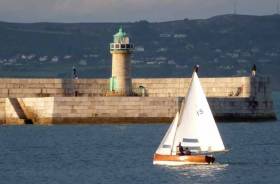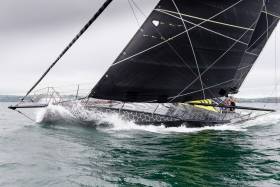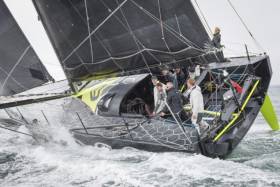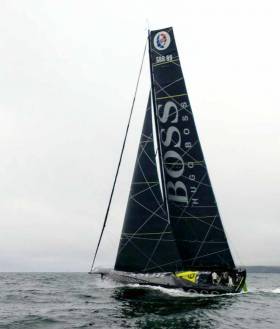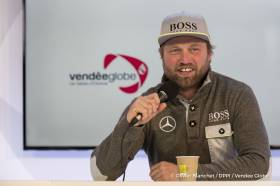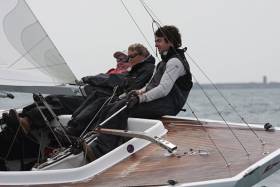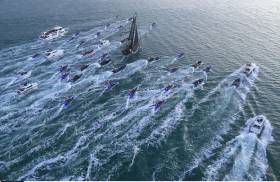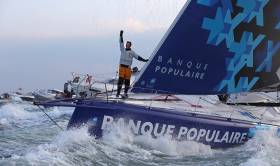Displaying items by tag: Vendee Globe
Nin O’Leary & Alex Thomson Share The Stage with History in Dun Laoghaire
The rapidly-developing partnership between solo offshore veteran Alex Thomson and proven star of fully-crewed boats Nin O’Leary of Cork has been the focus of much attention this week as they visit Cork and Dun Laoghaire.
Thomson’s eye-catching IMOCA 60 Hugo Boss was leader for significant stages in the 2016-2017 Vendee Globe Race, and placed second at the finish in January. During August, his linkup with Crosshaven’s Nin O’Leary and the new Cork-based set–up of Ireland Ocean Racing has had the rumour mills running in overdrive, with much speculation and comment. W M Nixon found that the unique position of Dun Laoghaire provided a special occasion and a relaxed setting in which the prospects for this new and dynamic sailing relationship could be quietly and usefully discussed.
Every so often, the rest of us who sail from other ports are reminded that, in the final analysis, Dun Laoghaire is our sailing capital. Cork Harbour may be very much the national maritime centre, with Galway also making notable research input. But the extensive nature of Cork Harbour is such that it has several places and organisations which could claim to be its main focal point, so the effect is diffused. And while Galway successfully punches way above its weight, the fact that as a city it is only a fraction of the size of Dublin inevitably counts in rating its influence.
Thus Dublin is very much the capital, the place where major decisions are taken in all national areas including the maritime sphere. Dublin Bay is the main area for its sailing, well ahead in the numbers game. And Dun Laoghaire is uniquely the focal point for that sailing, a remarkable and historic artificial harbour through which the pulsing metropolitan energy interacts with the sea and recreational seafaring.
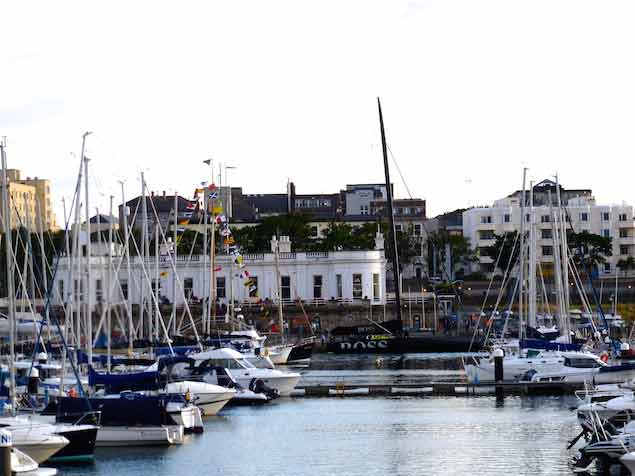 The brooding presence. The all-black IMOCA 60 Hugo Boss berthed at the Royal Irish Yacht Club. Photo: W M Nixon
The brooding presence. The all-black IMOCA 60 Hugo Boss berthed at the Royal Irish Yacht Club. Photo: W M Nixon
Yet at a different level, it is also the home port of many hobby sailors who simply see it as the conveniently-located local harbour which has ample facilities for their own sailing needs. Admittedly the affluence of the area in which it is located has meant that Dun Laoghaire has seen a significant influx of new non-woooden boats over the years, and it has lost some of the historic local One-Design classes which were once the bedrock of its highly-developed sailing scene. But even here, once it became clear that an important heritage was under threat, there has been a growing movement to preserve and expand the most historic class of all.
That has succeeded with the current great good health of the Dublin Bay Water Wag, the world’s first One-Design class, which started life as a simple double-ended little slip of a lug-rigged 13ft sailing dinghy in 1887, but by 1900 was in process of changing itself into a heftier transom-sterned gunter-sloop-rigged clinker-built boat 14ft 3ins long and 5ft 3 ins beam, with a heavy centreplate.
The new design commission was entrusted to boatbuilder J. E. Doyle in what was then Kingstown, but it’s generally reckoned the real designer was his daughter Maimie Doyle, whose talent lay in putting manners on her father’s extremely rough and often nonexistent sketches.
Whatever the design origins, the new boats were soon popular. But with other larger One-Designs available locally, each with its own adherents, it was thought good going if the racing turnout for the new Water Wags climbed above the fifteen mark before the Great War of 1914-1918.
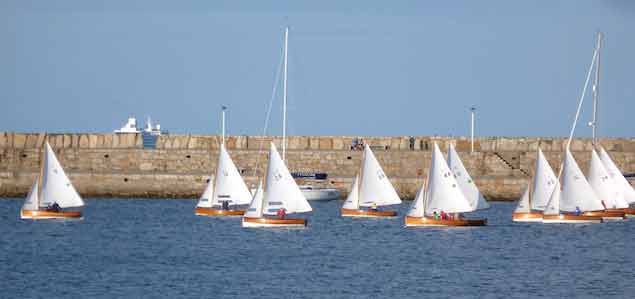 Race on! The Water Wags and Dun Laoghaire Harbour seem made for each other. Photo: W M Nixon
Race on! The Water Wags and Dun Laoghaire Harbour seem made for each other. Photo: W M Nixon
Dublin Bay proved to be ideal for the encouragement of several One-Design classes, but over the years the classic larger wooden boats left the stage to be replaced by more modern plastic boats, with the Dublin Bay 21s exiting in 1986, while in 2004 the Dublin Bay 24s sailed their last race, yet today it could be argued that they’ve been replaced by the growing Dublin Bay J/109 fleet.
A couple of post-World War II timber-built classes are still active in the Glens and the IDRA 14s, but the 17ft Dublin Bay Mermaids of 1932 provenance which originated in Dun Laoghaire are only a token presence, even if they thrive elsewhere. So now the main thrust of Dun Laoghaire enthusiasm for genuine classics sailing has devolved on the Water Wags, which today prosper as never before, and in 2017 with noted maritime historian Hal Sisk as the very active Class Captain, it was hoped they might finally achieve a racing turnout of 30 boats on the starting line.
One hundred and thirty years to become an overnight success? It could only happen in Dun Laoghaire. But as the Water Wags have been such a key part of the sailing fabric of this great harbour for so long, those in the know were well aware that the evening of Wednesday 30th August was the date set for the very special big push, the extra effort towards topping the thirty mark with the racing for the Captain’s Prize, with the fleet including helms and crews with Olympic experience.
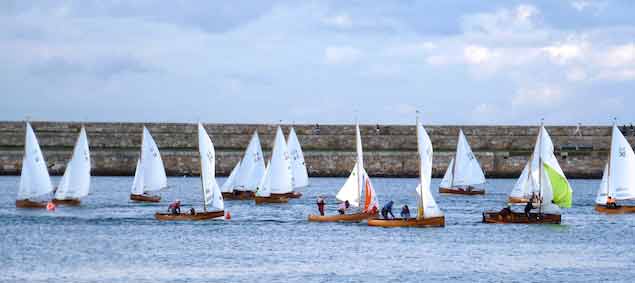 With the class rules’ insistence that spinnakers be set classical style entirely to weather, speed of setting varies enormously. Photo: W M Nixon
With the class rules’ insistence that spinnakers be set classical style entirely to weather, speed of setting varies enormously. Photo: W M Nixon
That racing in turn would be rounded out by a dinner held in the Captain’s own club to end the season’s evening racing. The Water Wags’ home bases are spread along the three older waterfront clubs, so the Captain’s Prize dinner 2017 was already scheduled for Hal’s own club, the Royal Irish, when news emerged that the mighty Hugo Boss, with the new Thomson/O’Leary combo on board, hoped to visit Dun Laoghaire for a couple of days in the last week of August, and could the RIYC accommodate their promotional needs to be seen, be accessible, and provide a base for shore entertainment?
The visit would clash either with the Water Wags special race on Wednesday, or with the regular big-turnout Dublin Bay Sailing Club keelboat racing on Thursday. It fell to the RIYC’s Rear Commodore (House) Jacqueline McStay to decide how to play it, and she played a blinder.
Where others saw a problem, she saw an opportunity. She suggested that the planned dinners for the Water Wags and those involved with Hugo Boss should be turned into one single free-form event, using the RIYC’s historic dining room and spreading into the drawing room next door. She further suggested that as the Water Wags had seniority, Hal Sisk should be the main – indeed, possibly the only - speaker at the actual dinner.
But then, with a touch of genius, she suggested that while the Water Wags were out racing, it would be ever so obliging if Alex, Nin, and their genius boffin-organiser Stewart Hosford could give a little presentation to an audience of members and friends, in the club’s extensive basement room, about themselves, their own plans, and the boat’s movements in the weeks, months and maybe years ahead.
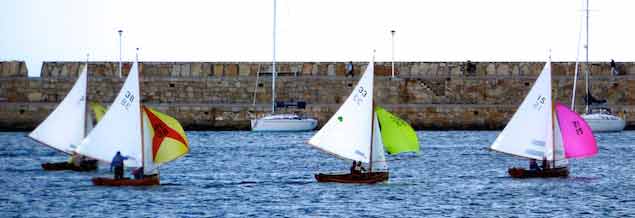 The leaders begin to emerge from the pack, with eventual winner Moosmie leading from Eva (33, Katie Tingle & Dermot O’Flynn), Swift (38, Guy Kilroy, sailed by David Somerville) and Pansy (3, Vincent Delany) Photo: W M Nixon
The leaders begin to emerge from the pack, with eventual winner Moosmie leading from Eva (33, Katie Tingle & Dermot O’Flynn), Swift (38, Guy Kilroy, sailed by David Somerville) and Pansy (3, Vincent Delany) Photo: W M Nixon
It was a masterplan for non-stop nautical entertainment for about six hours, beginning with the sniff around the Hugo Boss (“mighty machine” is an inadequate phrase here) followed by seeing the early stages of the Water Wags’ historic race, then breaking away to take in the presentation by the Talented Three in the basement, followed by the dinner when history and modernity got together, with the enjoyment of this providing a relaxed atmosphere for the exchange of information.
Pessimists would reckon this complex programme for one night in one club had endless opportunities for the wheels to come off, but it went so well you’d swear they did this sort of thing at least five nights a week. As with all Irish events of an outdoor/indoor nature, the Great Imponderable was the weather, and the forecast 24 hours earlier wasn’t at all cheerful. Yet despite that they managed to rouse out a world record of 31 “new” Water Wags, and the photos say everything about perfect conditions for the last evening race of the summer.
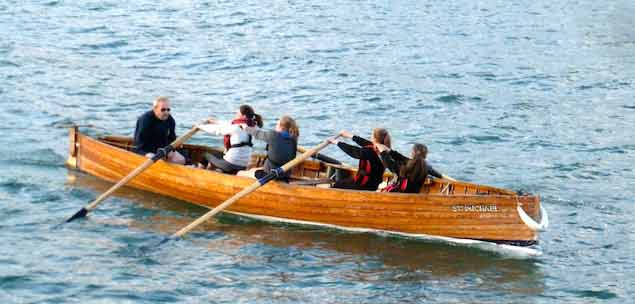 A shared harbour. Trainee crew out for the evening with St Michael’s Rowing Club.Photo: W M Nixon
A shared harbour. Trainee crew out for the evening with St Michael’s Rowing Club.Photo: W M Nixon
It also provided ideal circumstances for a consideration of the current condition of Dun Laoghaire. The place isn’t helped by being in a state of limbo. I’d optimistically hoped that I could get a good shoreside overview of the race by somehow getting myself to the end of St Michael’s Pier at mid-harbour, but it’s still all blocked off as they battle back and forth about the provision or otherwise of a liner berth.
In other words, the shoreside of the harbour is basically inaccessible to the public except down the marina breakwater, but even that limited viewpoint showed that this was a race in a million. And the quality of construction of the main harbour is such that it’s a joy to behold on such an evening, while within it the Water Wags shared the space with skiffs of St Michael’s Rowing Club and boats out from the Irish National Sailing School. Conditions improved as the race went along, with a freshening breeze sharpened up by a long black cloud which moved slowly over towards Howth, leaving crisp evening sunshine behind it, and a markedly veering breeze for the final beat of a four leg windward-leeward course.
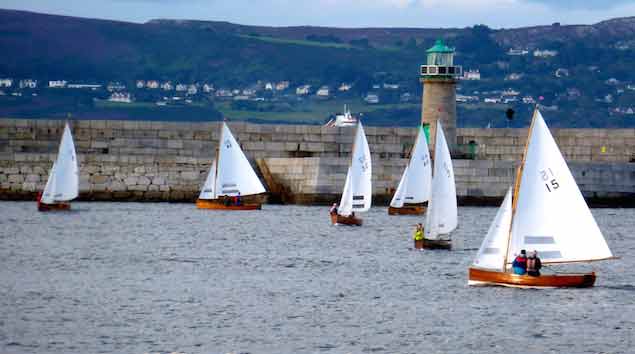 Moosmie (15) seems to have it nicely under control going over to the tricky west side of the harbour…….Photo: W M Nixon
Moosmie (15) seems to have it nicely under control going over to the tricky west side of the harbour…….Photo: W M Nixon
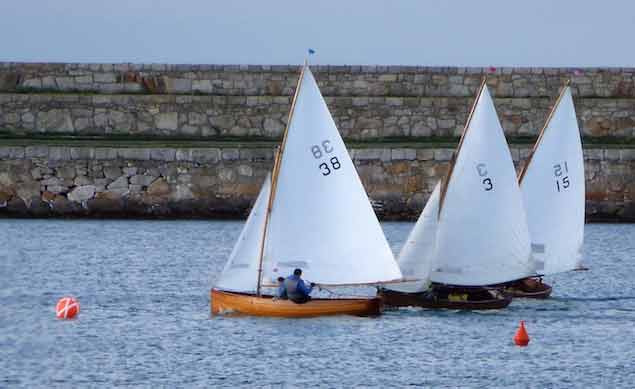 ……but finds herself at the weather mark temporarily behind Swift (38, Guy Kilroy sailed by David Somerville) and Pansy (3, Vincent Delany) Photo: W M Nixon
……but finds herself at the weather mark temporarily behind Swift (38, Guy Kilroy sailed by David Somerville) and Pansy (3, Vincent Delany) Photo: W M Nixon
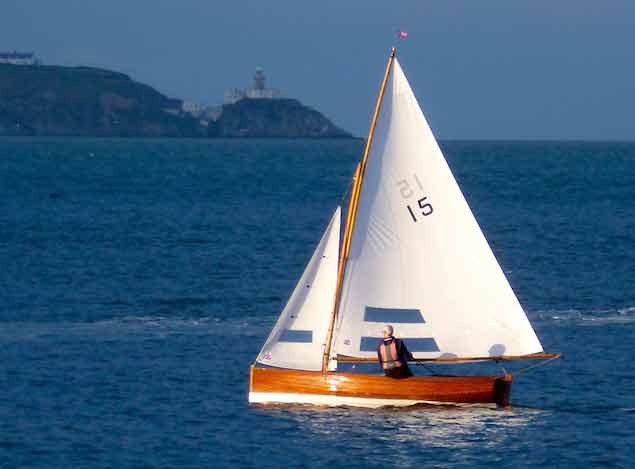 Moosmie clear ahead again. Photo: W M Nixon
Moosmie clear ahead again. Photo: W M Nixon
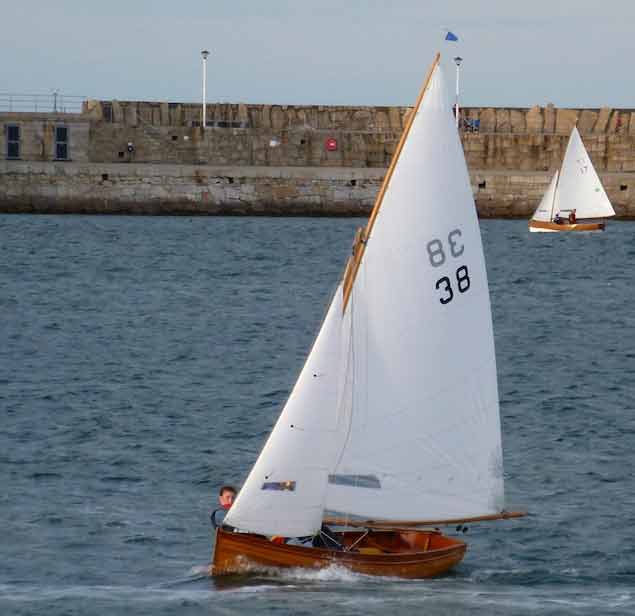 Modern sail-making materials have greatly improved the appearance of the Water Wags. With cotton sails, they often had a starved look, but today’s sailplan looks well fed. This is Guy Kilroy’s 2001-built Swift raced on Wednesday to fifth place by David Somerville. Photo: W M Nixon
Modern sail-making materials have greatly improved the appearance of the Water Wags. With cotton sails, they often had a starved look, but today’s sailplan looks well fed. This is Guy Kilroy’s 2001-built Swift raced on Wednesday to fifth place by David Somerville. Photo: W M Nixon
Thus although David and Sally MacFarlane in the 107-year-old Moosmie (no 15) had overcome a setback or two to retain the lead and sometimes show well clear ahead, the finish came with a bit of a rush of boats in from the right hand side of the beat. While Cathy MacAleavey and Con Murphy were second across in her new Mariposa, finish signal came there none - they’d been OCS. But it was the night of nights for the class’s only Howth owners, Ian & Judith Malcolm with the 102-year-old Barbara. They’d been 21st round the leeward mark, but went onto port and headed straight at that black cloud sitting plumb over their house on the southwestern flanks of the Hill of Howth.
They got themselves a mighty freeing for the tack to starboard, and came roaring in toward the finish picking off places by the handful, and finding that the leaders for much of the race were in a bit of a tangle towards the line. So they weathered the lot of them and swept in to take a neat second, making it non-Dun Laoghaire sailors in two of the top places for this Race of Races, as Katie Tingle of Cork was third and winner of IB with Eva, crewed by Dermot O’Flynn.
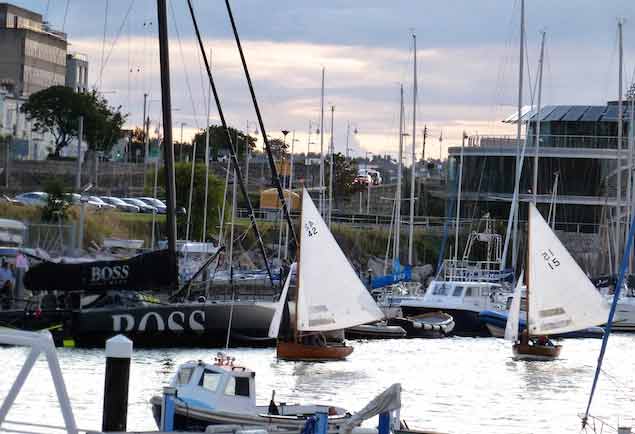 Back to base. Hugo Boss waiting to welcome William Prentice & Moiselle Hogan’s Tortoise (42, built 2006, placed 4th) and winner Mousmie (built 1910) as they return to the Royal Irish YC. Photo: W M Nixon
Back to base. Hugo Boss waiting to welcome William Prentice & Moiselle Hogan’s Tortoise (42, built 2006, placed 4th) and winner Mousmie (built 1910) as they return to the Royal Irish YC. Photo: W M Nixon
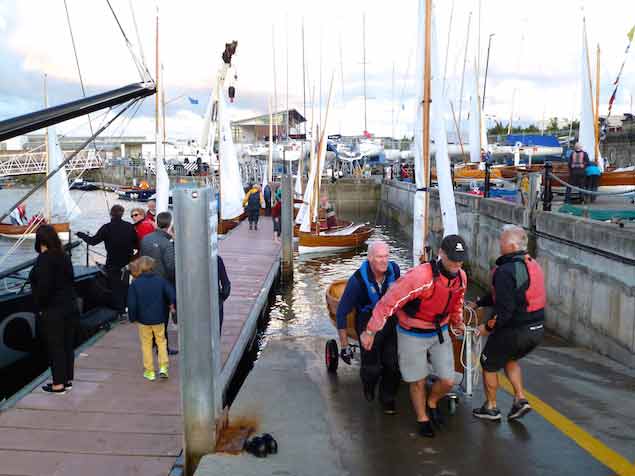 Help is always welcome when hauling a Water Wag on the slip, even at high water. Photo: W M Nixon
Help is always welcome when hauling a Water Wag on the slip, even at high water. Photo: W M Nixon
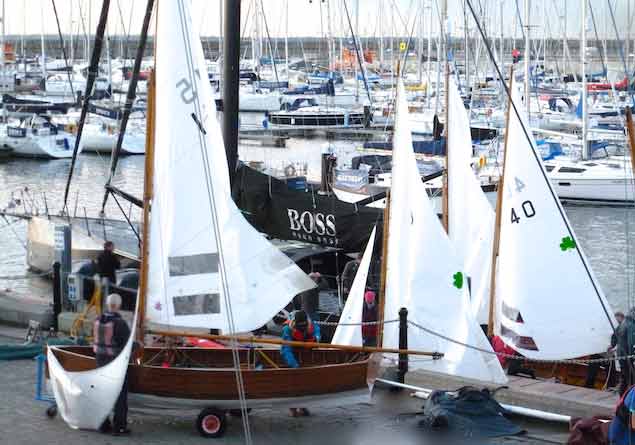 The perfect evening. The winner Moosmie (foreground) is un-rigged after being the first to win from 30 other boats, and Hugo Boss is there to see it all happen. Photo: W M Nixon
The perfect evening. The winner Moosmie (foreground) is un-rigged after being the first to win from 30 other boats, and Hugo Boss is there to see it all happen. Photo: W M Nixon
It’s a good idea to do well in the racing, as it lessens your queuing time to get up the club slips. The atmosphere around the Water Wags is so basically light-hearted – even when they’re hauling these quite heavy little boats back up the slip – that it took a while to adjust to the next mood-stage of the evening, the underlying utter seriousness involved in racing an IMOCA 60 like Hugo Boss, and particularly in such totally extreme sport as the Vendee Globe Race. Alex Thomson does a wonderful line in light-hearted patter, but what he does is mind-blowingly all-involving, and as he talked us through the financial, physical and most importantly psychological requirements for anyone even beginning to contemplate such a thing, you were left in bewilderment in grasping the scale of it all.
As to the matter of how and why he moves about the boat without being apparently concerned about being directly attached to her, he created a certain silence by saying that as you’re often sailing at 25 knots, going overboard on the end of a wire or something similar would bring the certainty of getting dragged to a particularly nasty drowning death.
Only a hundred or so people have managed to sail round the world non-stop, so there’s a real sense of community among those who have done it, and they in turn respect those who have made a whole-hearted attempt to do the same. A real high-point came when Enda O Coineen burst out of the audience and went forward to present his old mate Alex Thomson with a replacement cap for one which had been exchanged a long time ago.
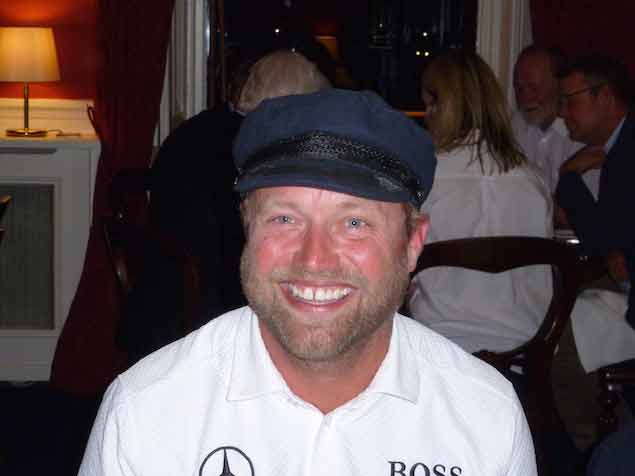 Alex Thomson with his new cap from Enda O Coineen. Photo: W M Nixon
Alex Thomson with his new cap from Enda O Coineen. Photo: W M Nixon
Stewart Hosford didn’t quite bewilder us with science, but he has such mental energy that there are times you think he’s operating on a different planet, while as for Nin O’Leary, he talked of their hopes and how he is finding it all coming together - or not. He faces a monumental challenge.
Certainly fund-raising is something that all these sailing superstars seem to gravitate towards pretty quickly, and it was in the Water Wags/Hugo Boss dinner afterwards that we could ask real questions, for the gathering in the basement room had been a pubic presentation and emphatically not a press conference. Come to that, nor was the dinner either, but things gets said across a table, and an early revelation from a notable Man Who Knows in the RIYC was that the next America’s Cup will be in skinny 73ft monohulls with enormous canting keels, which would seem to indicate that the Alinghi man who was the real backer of Team NZ is carrying the day.
Then, in his Water Wag Class Captain’s speech, Hal Sisk was in fine form, handing out the prizes with style, and taking the opportunity to present Alex Thompson with his fascinating book which convincingly argues that Dublin Bay was the cradle of modern yacht racing. Knowing that Baghdad was the cradle of civilisation, I’m not too sure that being the cradle of anything is necessarily a good thing for future prospects, but doubtless the book will have a special place in Hugo Boss’s on-board library.
As a very pleasant evening wore on, the talk became more relaxed, and in chatting about the lack of Fastnet Race success, Nin O’Leary confirmed that the construction of Hugo Boss is so specialised that any modification to fit ordinary dagger boards instead of foils would be prohibitively expense, and of limited use in hitting the overall target of a boat designed specifically for Vendee conditions, which are 90% offwind.
Thus in that frustrating upwind slog from Land’s End to the Fastnet, when holding on port tack was soon the only choice because of the huge Traffic Separation Zone, they were making ten degrees of leeway. And once they finally got to the Fastnet, there just weren’t enough miles left in getting to Plymouth to take more than one place in the IMOCA 60 class.
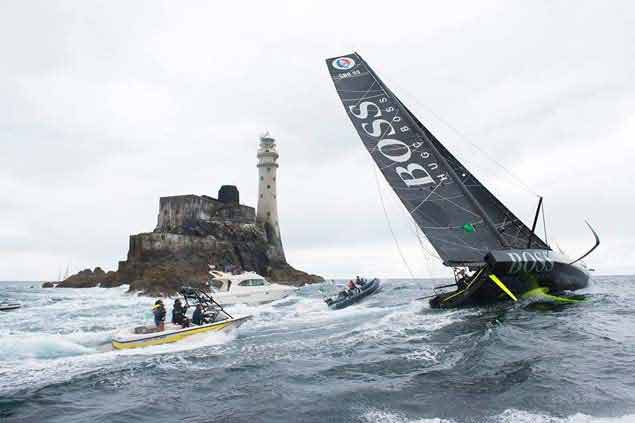 Hugo Boss with the fan club as she arrives at the Fastnet. The extreme offwind foil configuration means she makes about ten degrees of leeway when hard on the wind
Hugo Boss with the fan club as she arrives at the Fastnet. The extreme offwind foil configuration means she makes about ten degrees of leeway when hard on the wind
The problem is that with such a purpose-designed boat, the number of useful events is limited. In the interim, between races which suit, they have to make do with what’s available, so their next outing will be the Middle Sea Race on 28th October. The winds in that are notoriously all over the place, but who knows, they might get lucky, and it’s all experience even though they’re allowed to carry extra hands. But it won’t be more than three at most, as more bodies just get in the way in a cockpit optimised for one.
For Alex Thomson, the Hugo Boss sponsorship, with major support from Mercedes, is in place for 2020, but his team are willing to take in any extra interest, as the boat we were being amazed by at the Royal Irish cost a basic of €5 million, and a new one won’t be any cheaper. As for Nin O’Leary, he seems to be aiming for a boat he can initially secure for €3.6 million, but will need continuing investment thereafter.
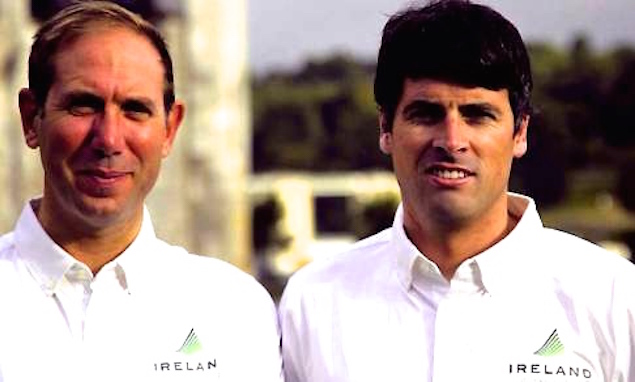 Stewart Hosford and Nin O’Leary
Stewart Hosford and Nin O’Leary
You cannot but be intrigued by the Hugo Boss setup. The boat looks and is the quintessential expression of modern German industry and commerce. Yet she’s sailed by a jolly Englishman whose main performance theatre is provided by France. And the technical management behind it all is provided by a peripatetic Corkman.
Into this whirling maelstrom of possbilities and challenges has stepped a 31-year-old Irish sailing star who is learning just as fast as he can by sailing as co-skipper on Hugo Boss, yet the logic is that he in time will have to think of his own boat. In fact, everybody is taking a very mature approach to this. The only relative certainty is that they’ll be doing the Middle Sea Race together in eight weeks time. Beyond that, the ideal might be the two-handed Barcelona World Race in May 2018, but if Nin O’Leary has his own boat by that time, then he’ll be going with that, and Alex Thomson will have to find another co-sailor.
It’s a world of long-term goals in which you have to be prepared for changing situations from minute to minute, or even second to second. We’re astonished by the sheer challenge of the big events, without thinking of the shoreside work. The bigger the sponsorship, the more demanding the sponsor will expect to be of the star’s time.
Set against the innocent amateur sport of Water Wag racing, the contrast was total. You really couldn’t have asked for a better way of grasping the enormity of what these guys take on.
Nin O'Leary Sails into the Royal Irish Yacht Club For Dublin Launch of Irish Vendee Globe Campaign
The nation’s first offshore racing entity, 'Ireland Ocean Racing', made its Dublin landfall last night at the Royal Irish Yacht Club in Dun Laoghaire to announce its 2020 Vendée Globe campaign to an RIYC gathering.
Only 100 people have sailed single handed non-stop around the world and no Irish sailors have yet completed the Vendée Globe event but if Royal Cork's Nicholas O'Leary has his way, he'll be the first, the sailing crowd at the RIYC heard last night.
The club was buzzing with sailors as a world record turnout of Water Wags was achieved during the Captain's Prize race staged at the RIYC.
As Afloat.ie has previously reported, leading Irish sailor 'Nin' O’Leary will skipper the Irish entry and he aims to be the first Irish sailor to complete this exciting and incredibly arduous sporting challenge.
His boat for the campaign, Hugo Boss sped across Dublin Bay yesterday afternoon with both Alex Thomson and O'Leary onboard. More Dublin Bay sails are planned to day and tomorrow.
Having shown Cork what the IMOCA 60 Hugo Boss can do, and even scored a photo op with the Durcan brothers, Nin O’Leary sailed into Dun Laoghaire yesterday morning on a mission that could define his Vendée Globe campaign. Speaking to Tom MacSweeney, he tells of his dream to race a “Formula 1” yacht in 2020, adding “I’m a very competitive guy”. But can he win his first battle to sup from the small sponsorship pot? That, admits team manager Stewart Hosford, is the €3million question. Listen to the full interview here.
Nin has competed across a range of sailing and racing events from an early age and has raced with his father, Anthony O’Leary, and brothers, Olympic sailor Peter O’Leary and Irish Champion sailor Robert O’Leary, to many victories. His achievements include winning the prestigious All Ireland ‘Champion of Champions’ an unprecedented three times, as well as being part of the Yes! Racing team.
Nin added his thoughts on his recent announcements:
“This is an important day for Irish offshore sailing and for me personally to lead the first Ireland Ocean Racing project . The campaign over the next 4 years building up to the Vendée Globe offers sponsors and investors a perfect partnership platform including branding, hospitality and dramatic content. I have just completed the Fastnet race with co-skipper Alex Thomson and now the real work starts in order to achieve the biggest challenge of all – the 2020 Vendée Globe.
I got to helm Hugo Boss for a while on Tuesday off Cork Harbour. The tiller surprised me. I thought, with the size and length of this IMOCA 60 round-the-world ocean racer, I would be holding a heavy tiller, requiring a lot of effort. It was light and the boat quickly responsive. The grinder, which I tried later, was different, heavy and demanding effort for the main and headsails, with serious sheet loads. A very impressive boat, a foiler, “nothing too complicated in the equipment,” I was told, everything capable of repair by the solo sailor.” The boat designed and built in weight for maximum speed achievement.
I was aboard to meet Cork sailor Nicholas ‘Nin’ O’Leary and Alex Thomson who raced it around the world in the last Vendee Globe, finishing second in January after 74 days, 19 hours and 35 minutes at sea alone, becoming the fastest British solo sailor ever.
Royal Cork Yacht Club member ‘Nin’ O’Leary intends to become the first Irishman to complete the race when he sails the next one in 2020. “I’m a very competitive guy,” he told me aboard, “I’m going to do it.”
He has been sailing with Thomson working-up to that aim. They sailed the Fastnet Race last month and may do the Barcelona World Race next year.
Listen to ‘Nin’ O’Leary on the PODCAST and to Stewart Hosford, CEO of ‘Ireland Ocean Racing,’ formally launched in Cork this week to “increase the profile of competitive Irish ocean sailing and racing, inspire a new generation of competitors and deliver future Irish champions in the sport.”
Hosford managed the Hugo Boss Alex Thomson campaign of which he has been CEO, so brings to the Irish campaign significant experience and expertise. “This is the start of a journey,” he told me. “It will need sponsors and investors. What can be achieved is huge.”
Only 100 sailors have succeeded in sailing single-handed non-stop around the world and no Irish sailor has yet completed the Vendée Globe. A Cork sailor could do that, if the project gets the support needed.
Hugo Boss left Cork heading for Dublin to spread the word and the prospects for ‘Ireland Ocean Racing.’
LISTEN to the PODCAST here:
Tom MacSweeney presents THIS ISLAND NATION maritime programme on radio stations around Ireland
Nin O'Leary's Vendee Globe Entry Trialling off Cork Harbour, Heading For Dublin Bay This Week
The new offshore racing entity, 'Ireland Ocean Racing', that will put Royal Cork Yacht Club's Nicholas O'Leary (31) at the helm of the IMOCA 60 Hugo Boss on the 2020 Vendée Globe start line is sailing off Cork Harbour.
As Afloat.ie reported previously, the demo sails are part of the launch of the world–girdling project that will arrive into Dun Laoghaire Harbour on Wednesday or Thursday. O’Leary, son of Royal Cork's Anthony and Sally O'Leary, wants to be the first Irish sailor to complete the non–stop round the world challenge. He'll be following in the wake of plucky Enda O'Coineen's ill–fated Kilcullen that was dismasted in the last race off New Zealand in December.
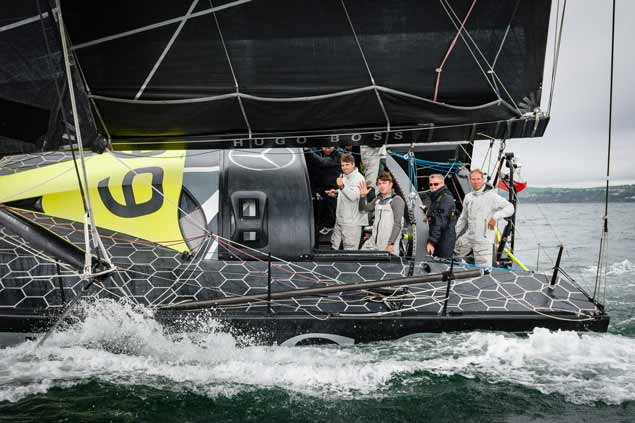 (Above and below) The Ireland Ocean Racing Team onboard Hugo Boss. Photos: Bob Bateman
(Above and below) The Ireland Ocean Racing Team onboard Hugo Boss. Photos: Bob Bateman
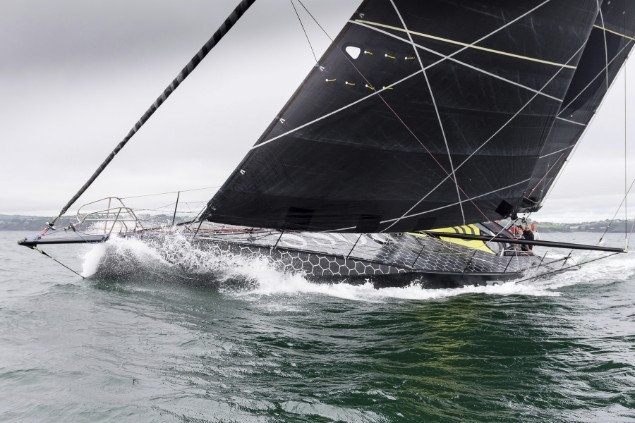
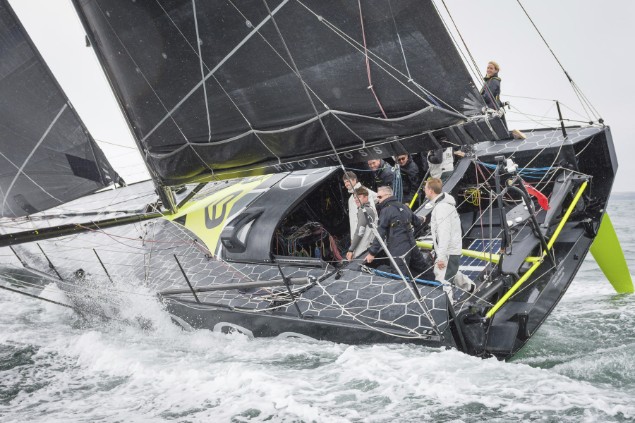
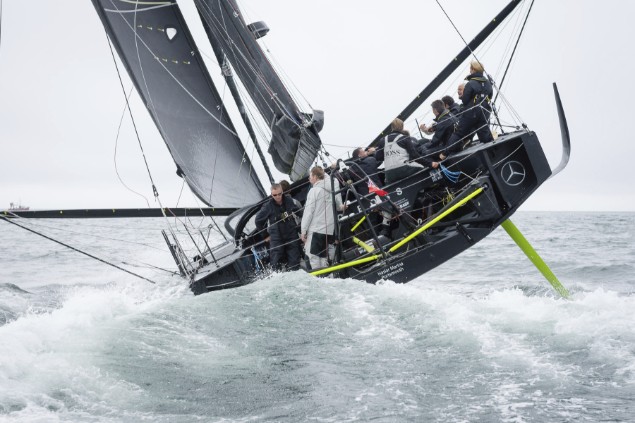
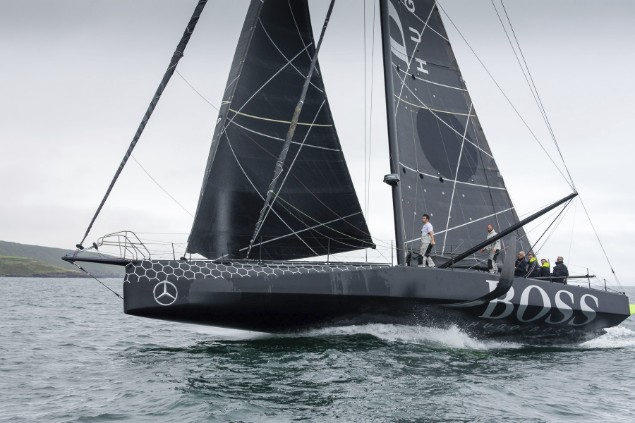
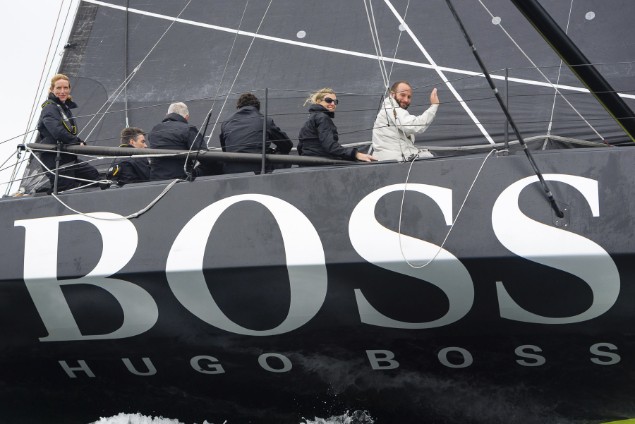
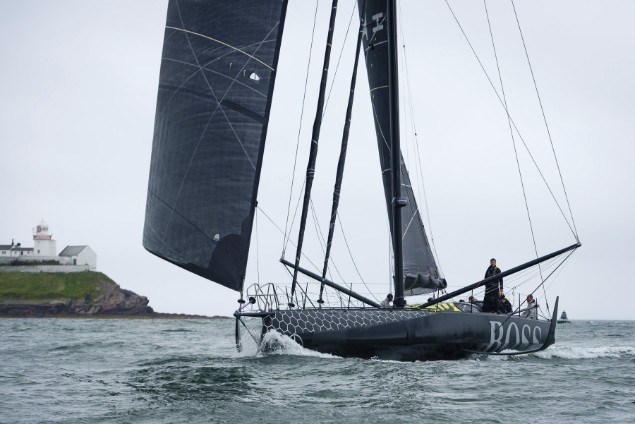
O'Leary's team say he is expected into Dublin Bay on August 30.
Read more in WM Nixon's blog: How Much in the Sponsorship Pot for all These Irish Offshore Sailing Superstar Hopefuls?
Solent Crowds Welcome British Sailor Alex Thomson Home After Vendée Globe Achievement
Vendee Globe sailor Alex Thomson was welcomed home today by crowds of people who gathered to celebrate the sailor’s record breaking effort in the prestigious Vendée Globe, widely renowned as one of sport’s toughest challenges.
Thomson finished second in this year’s edition of the solo, non-stop, race around the world, crossing the finish line on Friday 20th January 2017. Thomson completed the gruelling race in just 74 days, 19 hours and 35 minutes, becoming the fastest Brit to ever sail solo around the world in a monohull.
Many boats joined Thomson in a Parade of Sail this morning, commencing in the Solent and travelling through Portsmouth Harbour before berthing Thomson’s racing yacht, HUGO BOSS, at the Gosport Ferry Terminal. Thomson was welcomed ashore by the Mayor of Gosport for a civic reception, as well as answering questions from the crowd of excited fans.
Thomson commented, “I am always overwhelmed by the support I receive from my local community, but today has been particularly special. I’m truly honoured that these crowds came out to celebrate not only my achievement, but also the work of my team both before and during the race, today is as much a day for them as it is for me and it is something none of us will ever forget.”
As well as breaking his previous around the world race record of 80 days, Thomson has matched Dame Ellen MacArthur’s second place finish which she achieved back in the 2001 edition of the race.
CEO of Alex Thomson Racing, Stewart Hosford, said: “We are incredibly proud of what Alex has achieved and are delighted to see the tremendous support from our local community. An achievement such as this is the result of four years of extremely hard work and preparation from both Alex and the team behind the scenes and it is fantastic to be able to celebrate such a fantastic result.”
The Vendée Globe is a single-handed, non-stop, unassisted race around the world. Often termed ‘the Everest of Sailing’, the race– which takes place just once every four years – pushes sailors to their very limits, requiring them to compete alone at sea without stopping, setting foot on dry land, or receiving any form of assistance for almost three months.
The 2016-17 edition of the Vendée Globe began on Sunday, November 6th when Thomson, alongside 28 fellow skippers, set sail from Les Sables d’Olonne, France. The race was won by Frenchman Armel Le Cleac’h who sealed victory on 19th January 2017, finishing just 15 hours, 59 minutes and 29 seconds ahead of Thomson.
Three Vendee Globe Skipper Finish Within Three Hours
Vendée Globe history was made today when three solo skippers crossed the finish line at one after the other within three hours of each other, the closest finish between a trio of boats since the solo non stop around the world race was first contested in 1989.
Jean Pierre Dick crossed the finish line at 13:47:45hrs UTC to secure fourth place for the second consecutive time. Yann Eliès exorcised the ghosts of his horrific 2008-9 accident when he broke the finish line at the Nouch Buoy to complete the Vendée Globe for the first time at 15:13:09hrs UTC, one hour and 25 minutes after Dick. In fifth place Eliès’ Quéguiner-Leucemie Espoir is the first IMOCA configured with straight daggerboards as opposed to the new generation foils. One hour and 30 minutes later, at 16:43:54hrs Jean Le Cam brought his Finistère Mer Vent across the finish line to take sixth place.
The trio were largely compressed together by a big storm to the south of Australia. Dick routed over 400 miles to the north to pass through the Bass Strait, the first Vendée Globe skipper ever to route north of Tasmania in order to avoid the worst of the violent weather. Meanwhile Eliès and Le Cam slowed and rode out the worst of the weather in the south of the system, Eliès spending more than 24 hours hove to in gale force winds. On his foil assisted latest generation St Michel-Virbac, Dick was able to build his lead again but was caught each time in calms. Eliès and Le Cam spent long periods racing in close proximity to each other. Suspense held right into the final hours of their race. Dick’s lead of 70 miles last night was cut to seven at one point before he was able to extend away when the breeze finally build again for him this morning.
Dick admitted that although he was disappointed to have missed his target, a place on the podium, he was satisfied to have held off the attacks of the two highly experienced and successful French skippers, Eliès and Le Cam, both three times winners of La Solitaire du Figaro, the one design solo offshore stage race which remains the proving and training ground for French ocean racers. Indeed, for his tenacity in fending off Le Cam and himself, both three times winners of La Solitaire du Figaro, Yann Eliès decreed JP Dick an ‘honorary Figariste’ when they shared the same stage this afternoon. “It was good in our race within the race, competing against such incredible skippers as Yann and Jean with a lot of experience and it gives me a good feeling to finish ahead of them. The podium was my target and so to miss out is disappointing,” admitted Dick. “There were a lot of calms and a lot of comebacks. It was good for spectators but hard for me.”
Dick’s St Michel Virbac IMOCA spent last winter being structurally reinforced after problems forced him out of last autumn’s Transat Jacques Vabre, the new boat’s maiden race. The skipper who originates from Nice pointed to his lack of time on his boat, not knowing the fine detail of how to trim and set up his boat in the first weeks of the race, as the root cause of his initial losses to the top five boats. “I am happy to get back. I enjoy being at sea. But I missed the knowledge of the boat, the small details, I missed the keys to the boat in the first weeks and that was hard psychologically. To lose 500 miles was hard psychologically. I felt like I was missing little things like how to set up and trim the boat, the finesse. But I had a good climb back up the Atlantic to start with.”
Eliès was objective, admitting that he thought memories of his 2008-9 accident and rescue would not really affect him as much as they did. “I watched Jérémie Beyou’s press conference and was very moved by what he said. It didn’t really surprise me because we’re so close out on the water and in life. I may well have said that the accident wasn’t a problem, but I realised in the first few hours that it was affecting me. I found it hard to settle into the race. It was hard leaving the family behind. I hadn’t realised it was going to be so hard. Then I started to have a few technical problems with my sails. Gradually I overcame the problems and managed to exorcise that moment from my life. This Vendée Globe resembled how I imagined it with my team and sponsors – a reasonable approach. Eighty days is long, so finding myself in a battle with Jean-Pierre and Jean kept me busy. I preferred the 52 and 60-day Jules Verne attempts as 80 days is so long. Next time I'll go on a foiler! I was a bit worried when JP went through the Bass Strait and I got my fingers burned. I told myself a little bit more wind and I would really have been in a mess and not be able to bring the boat home safely.”
4. Jean Pierre Dick, St Michel-Virbac, Elapsed Time 80d 01h 45m 45s, +5d 22h 09m 59s after first, average 12.75kts on theoretical route of 24,499.52NMs. Sailed 27,857.09NMs at average of 14.5kts
5 Yann Elies, Quéguiner-Leucemie Espoir, Elapsed Time 80d 03h 11m 09s, +5d 23h 35m 23s, +1h 25m 24s after fourth. 12.74kts average on theoretical course. Sailed 27,138.58NMs at 14.11ktrs
6 Jean Le Cam, Finistere Mer Vent, Elapsed Time 80d 04h 41m 54s, +6d 01h 06m 08s after first, +1h30m45s after 5th, 12.73kts on theoretical course. Sailed 27,114.91Nms at average 14.1kts.
Alex Thomson Talks Vendee Globe Race 2020
Two days after finishing second in the Vendée Globe, British skipper Alex Thomson is recovering well in the start and finish host town of Les Sables d’Olonne on the west coast of France. He has been enjoying family time, taking every chance to spend some hours with his young son and daughter in between resting and completing a whirlwind schedule of media interviews.
When he joined Vendée LIVE in French and English today, he enthralled a ‘standing room only’ packed house comprising local ‘Sablais’, French and international Vendée Globe fans, with his ready wit, his frank and full answers and his undimmed passion for the legendary solo non stop race around the world. Thomson confirmed today that he intends to do the race again in 2020, looking to add a win to his third and second places but only if he can put together a fully competitive programme. On a lighter note Thomson told how, the morning after finishing his gruelling 74 day race, he took his kids to the swimming pool of his hotel to be greeted in the water by his rival, race winner Armel Le Cléac’h who he had been racing head to head with him for 90 per cent of the 27,000 mile course. Before he moves forward with the next phase of his racing career, Thomson will take a holiday….sailing in the Caribbean.
The Hugo Boss skipper laughed: “My wife has booked our dream sailing holiday together in the Caribbean. She has promised we have double beds, flushing toilet and fridge, freezer and lots of beer and rum. We are off to do that.” Having now had a little time to discuss future Vendée Globe plans with his wife Kate and his core team, he is keen to complete the story with a win: “Third last time, second this time. It is obvious what we need to do. What I need to do is to have a competitive campaign to do it again and the level of commitment from my family, from my team, from my team’s families. It means we need the right funding, but the most important thing is the people and the very next thing is the funding.” Reviewing the emotional videos of his finish and return into the famous Les Sables d’Olonne channel, Thomson explained: “For me in the race I always feel it is very important not to think about the finish until it happens. Anything can happen right up until the finish line. Mike Golding lost his keel 50 miles from the finish. Even when I am 20 miles away, I am still not really telling myself I am about to finish. All the emotion, all the work you have put in, all the stress, it is not really over until that line. And then it just feels like the responsibility is lifted off your shoulders. I am not even sure you are really aware of the responsibility. Having to sleep with one eye open, you are constantly thinking of what can happen next.”
Of his ‘decompression’, his recovery since finishing he said: “It takes a few months to recover. I will be a few months in the gym. My gluteus maximus has turned to a gluteus minimus. I have got no quadriceps muscles any more. I am in pain walking around. Physically it is going to be lot of work. I am sleeping quite well. I normally sleep for only one or two hours for quite a long period after the race. I feel pretty exhausted. I really felt like the tank was empty this time. I actually have put weight on my stomach. My weight will have dropped though because you lose big muscles like your quads and your glutes, my legs are terrible, there is nothing there. One of the problems I did not tell people about is where the jib sheets come down through a block on the deck, the pulley where the rope does a 110 degree turn, stopped working about six weeks ago. And so I was dragging the ropes through the sheave. And I actually feel like my shoulder has moved forward in the socket.”
Speaking to Rich Wilson, the skipper of Great American IV, Thomson paid tribute to the American’s excellent energy generation systems, a combination of wind vane, hydrogenerator and solar panels which mean that he has barely used any diesel. “I used 200 litres of fuel,” said Thomson who fought energy generation issues almost all the way through his 2012-13 race, rebuilding hydrogenerators and struggling for long period with very limited energy, hence his choice to go ‘belt and braces’ with diesel this time: “I had a tiny solar panel and my hydrogenerator was a back up. Mainly we were using diesel. But if we do another one I would to do it with using zero fuel. I love what you are doing and particularly what Conrad is doing. I think we should be going around the world without using any fossil fuels.” And he expressed his belief that the Vendée Globe should remain open and inclusive: “I think one of the great things is the amazing characters. If it was not set up the way it is then we would not have a Rich Wilson, we would not have had an Enda, we would not have a Sébastien Destremau. I think if there were 30 of me and Armel it would be a bit boring. Nandor Fa is extraordinary. To have a man who designed his own boat, who built it himself and is in eighth place. I have a real soft spot for him.”
The use of foiling appendages is in its infancy in the IMOCA 60 class which the Vendée Globe is raced in. Thomson want to see the class make the right decisions in the immediate future, to continue to develop fast, safe boats but considering costs and speeds relative to non-foiling boats: “We have just scratched the surface. The foils on our boat and those on Banque Populaire are slightly different. We were slightly better downwind but we were not so good in other areas. It was not a golden ticket. But we did go a very long way in a very short period of time. We have got longer. Our version 2 foils broke within three days and, yes, there will be a version 3 in due course. But we need to look at the data and see what we can do. There is an annual general meeting of the class in April. That will decide what the rule is. What is important is that we have a rule. It does not matter what it is. I think we need to be careful not to have a rule which makes what we do quite inefficient and very expensive. Like the America’s Cup. When they designed the boats they did not want them to foil, but Team New Zealand found how to make them foil, but in a very inefficient and almost dangerous way. I think that is what we need to do with IMOCA. We need to think about the costs too. There are seven boats foiling and on average each boat building two sets of foils. These foils are costing three or four hundred thousand pounds a pair, plus the cases. We don’t want the gap between the well-funded teams and the other teams to be too big. There is a lot of work to do. I sit on the executive committee of IMOCA, Armel Le Cléac’h is on the team, and Jéremie (Beyou).”
Neil O’Hagan Talks Tall Ship Plans, Enda’s Vendée Globe Challenge & More At Greystones SC Next Week
#SailingTalk - The next event in Greystones Sailing Club’s Winter Wednesdays series of talks hosts Neil O'Hagan of the Atlantic Youth Trust, the project that aims to bring about Ireland's next sail training tall ship.
O’Hagan is also on-shore co-ordinator for Kilcullen Team Ireland in the Vendée Globe, and he will have all the scuttlebutt on the highs and lows of Enda O’Coineen sailing Kilcullen Voyager, Ireland’s first entry in the round-the-world solo yachting challenge.
The date for diary is next Wednesday 25 January at 8pm, bar open from 7.30pm. You won’t want to miss it!
Thomson Finishes Second in Vendee Globe
Alex Thomson, the British sailor with strong Irish roots, has finished the Vendée Globe solo round the world yacht race in second-place after 74 days 19 hours 35 minutes and 15 seconds at sea.
Thomson, 42, crossed the finish line of the race in Les Sables d'Olonne, France, at 0737hrs UTC today on his 60ft racing yacht Hugo Boss.
He was 15h 59min 29s behind race winner Armel Le Cléac'h who finished in a time of 74 days, 3 hours and 35 minutes, a new race record.
Thomson covered 27,636 nm averaging 15.39 knots knots during the race, which began from Les Sables d'Olonne on November 6 last year.
The race, which was founded in 1989, follows the 'clipper route' around Africa's Cape of Good Hope, Australia's CapeLeeuwin and South America's Cape Horn.
Third-placed Jérémie Beyou is expected to cross the finish line on Monday morning (23rd January).
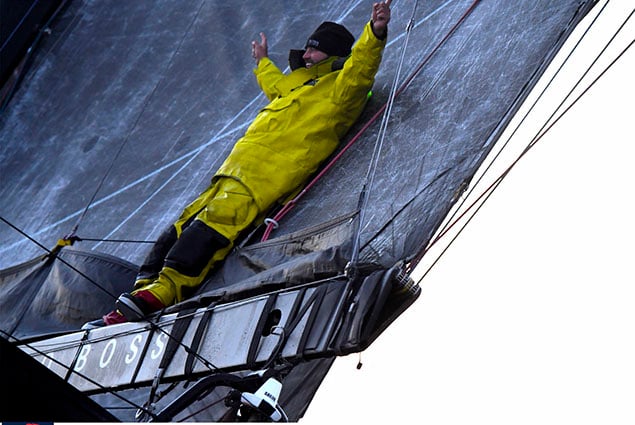 After 74 days, 19 hours and 35 minutes at sea, British sailor Alex Thomson reached the finish line of the Vendée Globe
After 74 days, 19 hours and 35 minutes at sea, British sailor Alex Thomson reached the finish line of the Vendée Globe
After 74 days, 19 hours and 35 minutes at sea, British sailor Alex Thomson reached the finish line of the Vendée Globe on his boat HUGO BOSS at 7:37 UTC Friday 20th January 2017, and in doing so broke his own British record of 80 days for the fastest solo circumnavigation of the globe in a monohull.
As well as becoming the fastest Brit to ever sail solo around the world, Thomson has matched Dame Ellen MacArthur’s second place finish which she achieved back in the 2001 edition of the race. Thomson’s achievements are all the more extraordinary for the fact that he suffered potentially race-ending damage to his boat on day 13 at sea. A collision with an unidentified object in the water caused his starboard foil to break, but even with this set back Alex has fought until the finish securing second place.
At one point, Thomson fell some 800 miles behind the leader, but delivered the greatest performance of his career to get himself back in contention and to set up one of the most thrilling final stages that the Vendée Globe has ever seen.
Over the past week, Thomson and first placed sailor, Armel Le Céac’h, have been involved in a sprint to the line, with Thomson continuing to gain miles on his French rival. In doing so, the British sailor broke the world speed record, and at one point pulled the difference back to less than 40 nautical miles. The two sailors continued to battle it out to the end, before Le Cleac’h finally sealed victory on Thursday afternoon.
The Vendée Globe is a single-handed, non-stop, unassisted race around the world. Often termed ‘the Everest of Sailing’, the race – which takes place just once every four years – pushes sailors to their very limits, requiring them to compete alone at sea without stopping, setting foot on dry land, or receiving any form of assistance for almost three months.
It is one of the world’s toughest sporting challenges, with only 72 sailors to ever complete the race since its inception. Dangerous and unpredictable, only 18 of the 29 sailors who began this edition of the Vendée Globe remain in the race. In the past, three skippers have lost their lives attempting to conquer the challenge.
Thomson, who was greeted by thousands of people who flocked to Les Sables d’Olonne on the west coast of France to witness his triumphant return, said: “It’s incredible to be here in second place, particularly given the loss of my starboard foil in the early part of the race. In our sport, challenges do not get any tougher, so this is a moment I will never forget.”
“This result is not just for me; it’s for my sponsor, for HUGO BOSS, for my family and friends who have supported me, and for my entire team who have worked tirelessly both before and throughout the race. We have put in years of preparation to get to the start and to ensure both the boat and me were in the best possible shape to take on this phenomenal race.
“To sail down the canal here in Les Sables d’Olonne, back where it all started on November 6th and to see huge crowds of people was an amazing feeling. And to be back with my wife Kate and children Oscar and Georgia again is emotional and very special.”
The 2016-17 edition of the Vendée Globe began on Sunday, November 6th when Thomson, alongside 28 fellow skippers, set sail from Les Sables d’Olonne, France. Thomson and his team had spent more than two years ahead of the race designing and building a brand new IMOCA 60 race boat, HUGO BOSS. Despite the loss of the boat’s starboard foil early in the race, Thomson’s four years of intense training and preparation allowed for a recovery more defiant than anyone could ever have imaged.
CEO of Alex Thomson Racing, Stewart Hosford, said: “We are incredibly proud of what Alex has achieved. A race like this is the culmination of four years of hard work, training and preparation from both Alex and the team behind the scenes. We came here to win the Vendée Globe, but Alex’s 2nd place finish together with a number of new records is a superb achievement. Thank you to the team, sponsors and everyone who made this possible.”
Armel Le Cléac'h Wins Vendee Globe Race
French sailor Armel Le Cléac'h has today won the Vendée Globe, setting a new record for the solo non-stop round the world race in the process.
Le Cléac'h, 39, from Brittany, crossed the finish line of the race in Les Sables d'Olonne, France, at 1537hrs UTC after 74 days, 3 hours, 35 minutes and 46 seconds at sea on his 60ft racing yacht Banque Populaire VIII.
His time sets a new record for the race, beating the previous record of 78 days 2 hours 16 minutes set by French sailor Francois Gabart in the 2012-13 edition by 3 days, 22 hours and 41 minutes.
Le Cléac'h, the runner-up in the 2008-09 and 2012-13 editions of the Vendée Globe, covered 24,499.52 nm at an average speed of 13.77 knots during the race, which began from Les Sables d'Olonne on November 6 last year.
The Vendée Globe, which was founded in 1989, follows the 'clipper route' around Africa's Cape of Good Hope, Australia's Cape Leeuwin and South America's Cape Horn.
Second-placed Alex Thomson is expected to cross the finish line on his boat Hugo Boss around 12 hours behind Le Cléac'h.
The Full story of Armel Le Cléac'h's 2017 Vendee Globe victory
Armel Le Cléac'h's momentous victory in the Vendée Globe brings to an end an epic struggle with Alex Thomson that began the moment the 29-strong fleet left Les Sables d'Olonne on November 6.
Both sailors had built new-generation IMOCA 60 boats for the race that featured the addition of foils – L-shaped daggerboards that sit in the water providing lift and therefore extra speed in certain conditions. With two runners-up places from the past two editions of the race under his belt, Le Cléac'h began as one of the favourites to take the top spot this time round. Similarly Thomson was also tipped for the top as he began his fourth Vendée Globe looking to improve on his third-place finish of 2012-13.
Since the start on 6th November 2016 from Les Sables-d’Olonne, the Breton skipper from St. Pol de Léon in Morlaix Bay has had to use all his skill and experience as two times winner of the French summer classic, the Solitaire du Figaro, to ward off attacks from Britain’s Alex Thomson on Hugo Boss. Before the start, the skipper of Banque Populaire VIII spoke about his position as favourite in the 2016-2017 Vendée Globe. “It is the sailor, who makes all the difference. The one who comes out on top will be the one, who makes the fewest mistakes. We are setting off as pioneers, as no 60-foot monohull has ever sailed around the world with foils. I am one of the favourites, but I’m not the only one. There have been four transatlantic races since I started sailing on board Banque Populaire VIII and I won one of them.” Living up his reputation, the Jackal never gave an inch away, but the pressure was on him throughout the race from his British rival, Alex Thomson. Since 7th November, the day after the start, Le Cléac’h and Thomson have been taking it in turns as leader. “When I’m on a boat, I shift to warrior and adventurer mode,” explained the Breton skipper, who has looked solid physically and mentally during the whole race.
Le Cléac'h shot out of the blocks, taking an early lead alongside fellow Frenchman Vincent Riou, but by the Equator Thomson had a three-hour jump on the fleet after taking a shortcut through the Cape Verde Islands. Thomson's reference time to the Equator of nine days, seven hours and two minutes beat the existing record set by Jean Le Cam of 10 days and 11 hours. Disaster struck for Thomson on November 19 when a collision with an object floating in the waters of the South Atlantic destroyed his starboard foil, leaving just a stump sticking out. In spite of the setback Thomson rounded the Cape of Good Hope on the southern tip of South Africa in the lead four hours and 22 minutes ahead of Le Cléac’h, his time of seventeen days, 22 hours and 58 minutes obliterating the previous race record for the passage of 22 days and 23 hours set by Le Cléac'h in 2012.
The record pace carried on through the Indian Ocean with Thomson clinging to the top spot despite much of the action taking place on port, the tack on which Hugo Boss had a slight speed deficit due to the missing foil. As they reached the remote Kerguelen Islands Le Cléac'h was within touching distance of Thomson, finally overhauling him on December 3. The occasion was marked by a visit from a French navy helicopter, which was able to film incredible images of the two boats blasting along at almost 30 knots. It was the first time racing yachts have ever been filmed so far south. Le Cléac'h started to pull away but Thomson refused to let to go his French rival, staying within 100 miles at Australia's Cape Leeuwin. Again the race records fell, Le Cléac'h shaving off five days and 14 hours from François Gabart's 2012-13 record, and Banque Populaire accelerated away.
By Cape Horn Le Cléac'h had amassed a whopping 819nm lead on Thomson, the equivalent of two days on the water. Again Thomson replied with a blazing run up the South Atlantic that reduced the gap to just 50 miles by the Equator. Thomson's passage from Cape Horn has taken 13 days, five hours and 30 minutes, smashing 2012-13 Vendée Globe winner François Gabart's existing record for the passage by 14 hours.
With Le Cléac'h snared by the Doldrums the sprint through the North Atlantic began at slow pace, tricky weather systems confusing the leaders' route back to the finish line. Both skippers admitted to being mentally and physically exhausted as they pushed man and boat to the limit in pursuit of the ultimate prize. Extra pressure was heaped on Le Cléac'h when on January 16 Thomson set a new 24-hour distance record of sailed 536.81nm averaging 22.4 knots, breaking François Gabart's existing record by two miles.
In a nail-biting finale that had race fans on the edges of their seats, Le Cléac'h entered the final 24 with the narrowest of advantages, just 33 miles splitting his boat Banque Populaire VIII from Thomson's Hugo Boss. But by the time Le Cléac'h, nicknamed 'The Jackal' for his predatory nature on the water, got to within 200nm of the finish he had pulled away to create an unassailable buffer of 100nm. Thomson's final assault compounded by autopilot problems that left him dangerously tired and with Le Cléac'h out of reach he was forced to concede. Le Cléac'h sailed Banque Populaire VIII over the finish line at 1537 UTC in a time of 74 days, three hours, 35 minutes and 46 seconds to win the Vendée Globe and set a new race record in the process.
Despite the incredible length of the Vendée Globe the race is not unfamiliar with close finishes. In the very first edition winner Titouan Lamazou beat Loick Peyron by just 17 hours after 109 days at sea. In 2005 Vincent Riou came in just seven hours of Jean Le Cam to win the race, setting a new record time of 87 days, 10 hours and 47 minutes in the process. The closest finish the race has ever seen was in the previous edition when François Gabart beat Le Cléac'h by just three hours.


























